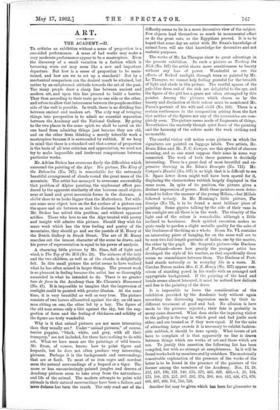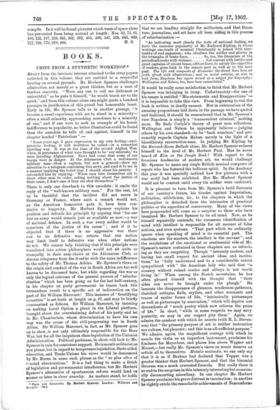ART.
THE ACADEMY.-IL
To criticise an exhibition without a sense of proportion is a one-sided performance. A. mass of bad works may make a very moderate performance appear to be a masterpiece. Even the discovery of a small variation in a fashion which is becoming worn out may seem like a new and important departure. But how is a sense of proportion to be main- tained, and how are we to set up a standard ? Not by a mechanical comparison can the desired result be attained, but rather by an enlightened attitude towards the art of the past. Too many people draw a sharp line between ancient and modern art, and upon this line proceed to build a barrier. They then according to their taste go to one side or the other, and refuse to allow that intercourse between the people on either side of the wall is possible. In truth, there is no dividing line between ancient and modern art. The only way of bringing things into perspective is to admit no essential separation between the Academy and the National Gallery. By going to the two places in the same spirit we shall be saved on the one hand from admiring things just because they are old, and on the other from thinking a merely tolerable work a masterpiece because it is surrounded by rubbish. If we keep in mind that there is a standard and that a sense of proportion is the basis of all true criticism and appreciation, we need not try to make impossible and irrelevant comparisons between particular works.
Mr. Adrian Stokes has overcome finely the difficulties which surround the painting of the Alps. His picture, The Sing of the Dolomites (No. 787), is remarkable for the extremely beautiful arrangement of clouds round the great mass of the mountain. The artist has managed to overcome successfully that problem of Alpine painting, the unpleasant effect pro- duced by the apparent similarity of size between small objects near at hand and great mountain forms in the distance. A clailet close to us looks bigger than the Matterhorn. Yet with- out some near object how on the flat surface of a picture can the space and air between us and the distance be expressed ? Mr. Stokes has solved this problem, and without apparent artifice. Those who love to see the Alps treated with poetry and insight will admire this picture. Should they wish for more work which has the true feeling and poetry of the mountains, they should go and see the pastels of M. Bussy at the Dutch Gallery in Brook Street. The art of M. Bussy searches out the inmost character of the scene he draws, and his power of representation is equal to his power of analysis.
A charming little picture by Mr. Sims, full of light and wind, is The Top of the Hill (No. 24). The airiness of the lady and the two children, as well as of the clouds, is delightfully felt. In this small picture the artist seems to have realised what he has often missed in larger things. The present work is so pleasant in feeling because the artist has so thoroughly succeeded in what he intended to do. There is no greater tour de force in the Academy than Mr. Clausen's Homeward (No. 47). It is impossible to imagine that the impression of sunlight could be painted with greater illusion. At the same time, it is very beautiful as well as very true. The picture consists of two horses silhouetted against the sky, an old man man sitting on one, the other led by a boy. The figure of the old man seems only a blot against the sky, but the sug- gestion of form and the feeling of thickness and solidity of the figure are truly wonderful.
Why is it that animal pictures are not more interesting than they usually are ? Under " animal pictures," of course, terrier puppies, "black, white, and grey, with all their trumpery," are not included, for these have nothing to do with art. What we here mean are the paintings of wild beasts. Mr. Swan, of course, knows how to paint tigers and leopards, but he does not often produce very interesting pictures. Perhaps it is the backgrounds and surroundings that are at fault. To most of us iron cages and sawdust teem the natural surroundings of a leopard or a tiger. The more or less unconvincingly painted jungles and deserts of Academy pictures seem to take away from the naturalness and life of the animal. The modern attempts to paint wild animals in their natural surroundings have been a failure, and 'mere dulness has been the result. The only road out of the difficulty seems to lie in a more decorative view of the subject. Few objects lend themselves so much to monumental effect as do the great cats, as the Egyptians proved. It is to be hoped that some day an artist with Mr. Swan's knowledge of animal form will use that knowledge for decorative and not realistic purposes.
The works of Mr.. La Thangue show to great advantage in the present exhibition. In such a picture as Tucking the Rick (No. 167) the artist shows more sensitiveness to beauty without any loss of power. Wonderful as are the effects of flecked sunlight through trees as painted by Mr. La Thangue, we cannot help feeling grateful for the breadth of light and shade in this picture. The restful spaces of the pale-blue dress and of the rick are delightful to the eye, and the figure of the girl has a grace not often attempted by this painter. Among the pictures which charm us by the beauty and distinction of their colour must be mentioned Mr. Furse's portrait of his wife and child (No. 169). There is a certain restlessness in the composition arising from the fact that neither of the figures nor any of the accessories are com- pletely seen. The picture seems made of fragments of things. Nevertheless the masterly though quiet force of the painting and the harmony of the colour make the work striking and memorable.
The careful visitor will notice some pictures in which the signatures are painted on luggage labels. Two artists, Mr. Denis Eden and Mr. F. C. Cowper, use this symbol of obscure meaning, and so one must suppose their aims in some way connected. The work of both these painters is decidedly interesting. There is a great deal of most beautiful and ex- pressive drawing in Mr. Eden's Decerpta (No. 711). Mr. Cowper's Hamlet (No. 507) is so high that it is difficult to flee it. Space lower down might well have been spared for it displacing the characterless rubbish largely displayed in the same room. In spite of its position, the picture gives a distinct impression of power. Both these painters seem deter- mined to follow the manner of the young Millais,-but Millais followed nobody. In Mr. Munning's little picture, The Gossips (No. 73), is to be found a most brilliant piece of painting. Some gipsies talking by the side of their vans in the sunlight are all there is in the work. The vivacity of the light and of the colour is remarkable, although a little inclined to harshness. Such spirited execution makes us quite ready to pardon a slight metallic quality for the sake of the freshness of the thing as a whole. Room No. VL contains an interesting piece of hanging, for on the same wall are to be seen two full-length portraits of ladies, one by the master, the other by the pupil. Mr. Sargent's picture-the Duchess of Portland-shows how greatly the younger artist has developed the style of his teacher, so that superficially there seems no resemblance between them. The Duchess of Port- land stands naturally as in everyday life in a room. M. Carolus Duran makes Mr•s. C. S. Henry (No. 327) appear con- scious of standing posed in his studio with an arranged and appropriate background. If the painting of the head and hands seems almost laboured, it must be noticed how delicate and fine is the painting of the dress.
It is impossible to leave the consideration of the exhibition provided by the Academic body without again recording the distressing impression made by their in- different treatment of good and bad. No allusion is here made to the pictures rejected ; their fate is probably in many cases deserved. What does strike the inquiring visitor to the gallery is the way in which good and bad jostle each other, and are treated as if they were equal. If for the sake of attracting large crowds it is necessary to exhibit fashion- able rubbish, it should be done openly. What lovers of art have to complain of is that apparently no line is drawn between things which are works of art and those which are not. To justify this assertion the following list has been compiled, but with no attempt at completeness. In it will be found works both by members and by outsiders. The most easily conceivable explanation of the presence of the works of the latter is to be found in the presence of the painters of the former among the members of the Academy. Nos. 13, 28, .112, 118, 130, 131, 140, 176, 378, 466, 469, 493,-1, 26, 164, 173, 188, 219, 257, 283, .292, 374, 390, 404, 413;426, 475, 676, 691, 697, 699, 701, 710, 728.
Another list may be given which' has been far *minter to
compile. In it will be found pictures which want of space alone has prevented from being noticed at length : Nos. 32, 73, 81, 103, 135, 187, 258, 361, 362, 392, 405, 506, 547, 558, 645, 689,







































 Previous page
Previous page